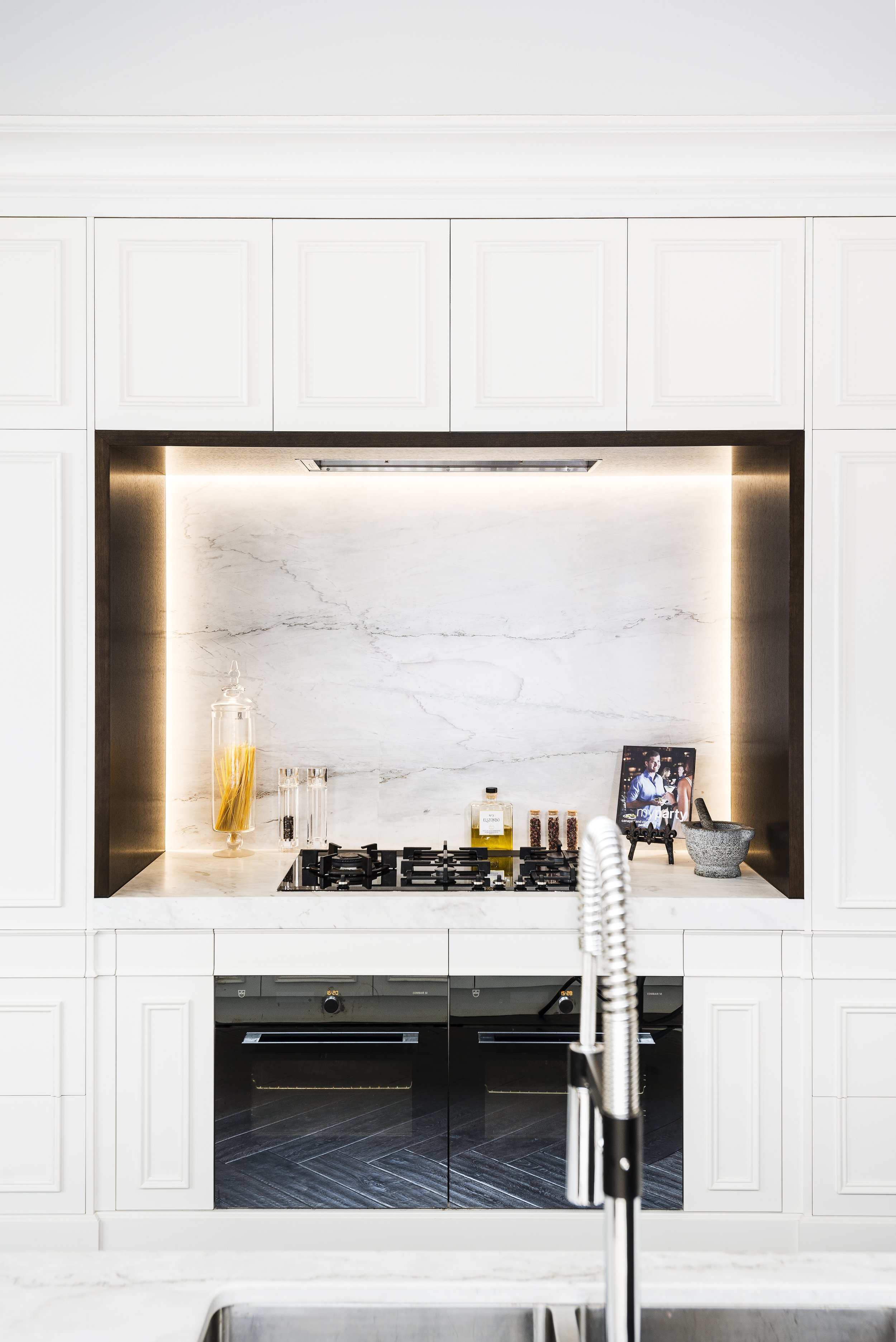
LIGHTING
BRING YOUR KITCHEN TO LIFE WITH LIGHTING
Light is an important consideration for kitchen design, & plays a pivotal role affecting both aesthetics & functionality. In a space where precision & safety are key, proper lighting is essential. From task lighting that brightens work areas to mood lighting that enhances the ambiance, every kitchen has unique lighting needs. Discover how the right lighting can transform your kitchen at our showrooms.
TYPES OF KITCHEN LIGHTING
AMBIENT LIGHTING
The foundation of your kitchen's lighting, providing a uniform glow for the entire space.
TASK LIGHTING
Focused, intense lighting for activities like cooking & cleaning.
MOOD LIGHTING
Used to accentuate features & create atmosphere.
NATURAL LIGHTING
Harnessing sunlight to brighten & energise your kitchen.
CHOOSING YOUR LIGHT & STYLE
LIGHT TYPE
Options range from bright white LEDs to softer halogens..
LIGHT FITTING
Selecting the right style of light fitting to complement your kitchen's design.
BULB TYPES
Consider energy-efficient options like LEDs & compact fluorescents for long-term savings.
LIGHT QUALITY
Assess the warmth & colour of the light. Dimming capabilities can add versatility to your lighting.
Consult with our designers for tailored lighting solutions.
TYPES OF LIGHTING
-
The purpose of ambient light is to create a diffused, even light level across a room, and it’s the first place to start when creating a lighting scheme.
’Ambient light’ can refer to a style of lighting scheme, but for our purposes, we’ll be talking about ‘ambient light’ as a direct source. Ambient lighting comes from lights on the ceiling, though sometimes a table or floor lamp can do the trick.
Ambient lighting can be a lone bright light on the ceiling or from a pendant light, or perhaps multiple smaller lights: like track lighting or recessed cans. These smaller lights all work together to create the main light source. They can be aimed in different directions to get into the nooks and crannies of your room. Most overhead lights use incandescent bulbs, which are inexpensive and come in a variety of wattages.
LED bulbs are greener alternatives that cost a little more, but last considerably longer than their incandescent and fluorescent counterparts. The downside is that LED lights have a reputation for casting overly bright and unattractive light, but manufacturers are continually improving their light quality.
Ambient light sources, while practical, need to be complemented with other kinds of lights to avoid a garish look. In the next section, we’ll talk about accent lighting. -
Accent lights, considered secondary in a room’s lighting design, are traditionally three to five times brighter than the ambient light level to create visual separation in a room.
Wall-mounted fixtures are a good example of accent lights, as are table and floor lamps. For example, in your dining room, a chandelier would provide the ambient light, and one or more wall sconces would create accent lighting.
Another use of accent lighting is to showcase a feature in a room, such as a painting. You’ve probably seen accent lighting in art museums, where the ambient light is usually dim, which invokes peace and quiet, while the accent lights focus your eyes on the art.
You can create this same dramatic effect in your home. If you have a large plant to showcase, consider placing an accent spotlight on the floor behind it, allowing the light to bounce off its leaves. Typically, a spotlight or floodlight is used to accent an object, though track lights also work in certain applications. -
Task lighting provides the primary light in a room and is ideally six to ten times brighter than the ambient light. It’s used to increase illumination above ambient levels at workspaces. Carefully chosen task lighting can minimise the need for overhead lights, which is helpful in conserving energy.
For our renovating ancestors, the term “task lighting” often referred to a lone bright bulb in a utilitarian desk lamp. Now, the options are endless. It’s a key element in a home where proper light is needed for a specific task or project, such as a reading light in the bedroom or a light next to your home phone in the butler's pantry.
There are many different kinds of lights that perform the job of a task light. Under-cabinet down lights or LED strip lights are helpful for kitchen tasks because typically, your shadow gets in the way of the ambient light source from above. LED lights are ideal for task lighting because they’re energy efficient and produce a clean, clear light that renders accurate colours. -
When asked to describe their most coveted space, many homeowners are quick to come up with adjectives like ‘light’ and ‘airy’. Natural light is a highly desirable form of light in a home simply because it makes everything look appealing. Lighting schemes that rely on the room’s natural light are called ‘daylighting’. Builders and architects are getting more requests for daylighting than ever before. After all, most of us spend numerous hours working indoors.
Daylighting keeps us connected with the outdoors, and studies have found that people who work in natural light are more productive. There are other benefits to natural light as well, such as savings on electricity.Daylighting is more detailed than embracing the sun’s rays. Glare can be an issue if the sun shines directly, or even indirectly, into the room. Managing heat and UV exposure is also crucial in Australia, typically best achieved through the use of curtains or shades. Painting a room in a light, reflective colour can help amp up the natural light, and the best ceiling colour to complement the light is the whitest white you can find.
TYPES OF FIXTURES
-
Often referred to as ‘can lights’, these fixtures consist of a housing that is mounted above the drywall in the ceiling.
Inside the housing is an adjustable bulb socket that can receive various bulbs. The can light is finished with a trim ring flush against the drywall. Can lighting is versatile, for example, providing general lighting in the kitchen, task lighting over the stove, sink, and counters, as well as accent lighting. There are many different kinds of can lights and trim rings for many types of uses. -
Pendant lights add a lot of style to a room and also provide general and task lighting. The designs for these fixtures are almost endless. They are particularly effective over kitchen islands, open counters, and sometimes dining tables. Pendant fixtures are often attached to the ceiling with a chain, cord, rod, or stem to the desired height.
-
Track lighting fixtures offer a wide range of applications. These fixtures consist of tracks that accommodate multiple track heads. These heads can be moved and pointed in different directions for the desired effect and adjusted later as needed. The tracks can be installed flush to the ceiling or hanging down, and they come in both straight and curved designs. There are a lot of different track heads and even pendants that hang down from the track. They are great for accent, general purpose and task lighting.
-
Under-cabinet lights are great for illuminating the area below wall cabinets. They also cast light on the kitchen backsplash and highlight your countertops. They come in many styles and serve as task and accent lighting. For optimal results, follow the installation instructions to ensure an even distribution of light.
Puck lights are small round lights often installed in cabinets with a glass door to highlight attractive items in the cabinets. They can be flush-mounted or cut into the cabinet top for a recessed look. -
Chandeliers, which hang down from the ceiling, typically feature multiple arms with light bulbs and decorative shades. They add a touch of elegance, often placed over kitchen islands and more commonly over kitchen tables. They provide general lighting using up lights, downs lights or exposed bulbs.
These fixtures provide general lighting, utilising up lights, down lights, or exposed bulbs for varied illumination. -
In kitchens, the space available for wall sconces is often limited due to the significant portion of wall area occupied by cabinets and counters. However, they add character and can be effectively used to flank a hutch or a piece of artwork, for instance.
-
Flush mount and semi-flush mount fixtures attach directly to the ceiling or hang down a few inches. These fixtures diffuse light through their lens and reflect it off the ceiling, providing general ambient lighting.
-
Dimmers and other lighting controls are highly beneficial in the kitchen, allowing you to adjust the light intensity to suit different activities. The ability to set or program your desired level of illumination adds convenience and flexibility to your kitchen. For example, while preparing food, you may prefer strong, bright light for clarity and precision. Conversely, during meal times, a softer, more subdued lighting can create a relaxed and enjoyable atmosphere.
COMMON KITCHEN LIGHTING MISTAKES
Using a single light fixture in the centre of the room often results in shadows across your workspace, as the light source tends to be behind you. This positioning not only leads to frustration but also increases the risk of accidents due to inadequate lighting. Additionally, it can cause a glare, particularly when looking into the kitchen from different angles.
For detailed guidance, visit our blog post on how to avoid kitchen lighting mistakes.
DESIGN TRENDS DELIVERED TO YOUR INBOX
Our design experts have curated their favourite trends & need-to-knows when renovating your kitchen.






